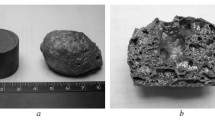Conclusions
-
1.
The addition of graphite to Ni-Cu and Ni-Fe alloys markedly reduces the extent and rate of shrinkage during sintering. At a graphite content of 50 vol. % densification gives way to volume growth. The addition of copper also produces greater volume growth than does the addition of iron.
-
2.
Varying the temperature in the range 1050–1200°C increases the rate of sintering, but has little effect on the linear dimensions and density of metal-graphite materials.
-
3.
The hypothesis is advanced that the volume growth of metal-graphite materials is mainly due to the formation of isolated inclusions between the particle surfaces, reaction with oxides, giving rise to gas evolution, and desorption of gases adsorbed on the graphite. As a result of these phenomena, the interparticle contacts are ruptured.
-
4.
The sinteringof copper-nickel composites is accompanied by homogenization and formation of solid solutions of copper in nickel, which take place rapidly at high sintering temperatures. The introduction of graphite separates the copper and nickel particles and hinders the formation of a homogeneous alloy; the degree of homogenization is the lower the higher the graphite content of the mixture. Concentration heterogeneity increases with rise in graphite content, but sintering for 2 h at 1150 or 1200°C yields alloys closely approximating to the median composition.
-
5.
The graphite in metal-graphite materials based on copper-nickel alloys constitutes an inert addition distributed as separate inclusions in a metallic matrix — a solid solution of copper in nickel. At a high graphite content, a continuous metallic skeleton fails to form in many places during sintering.
Similar content being viewed by others
Literature cited
S. D. Gertsriken and I. Ya. Dekhtyar, Solid-Phase Diffusion in Metals and Alloys [in Russian], Fizmatgiz, Moscow (1960).
Ya. E. Geguzin, Macroscopic Defects in Metals [in Russian], GONTI, Moscow (1962).
P. L. Gruzin, Yu. V. Kornev, and G. V. Kurdyumov, Dokl. Akad. Nauk SSSR,80, 1 (1951).
A. I. Raichenko, Poroshkovaya Met., No. 2, 35 (1961).
M. Hansen and K. P. Anderko, Constitution of Binary Alloys, McGraw-Hill, New York (1957).
Author information
Authors and Affiliations
Additional information
Deceased.
Translated from Poroshkovaya Metallurgiya, No. 10 (106), pp. 26–31, October, 1971.
Rights and permissions
About this article
Cite this article
Itin, V.I., Kozlov, Y.I., Pugina, L.I. et al. Sintering process, structure, and phase composition of metal-graphite materials based on nickel alloys. Powder Metall Met Ceram 10, 786–789 (1971). https://doi.org/10.1007/BF00794168
Received:
Issue Date:
DOI: https://doi.org/10.1007/BF00794168



